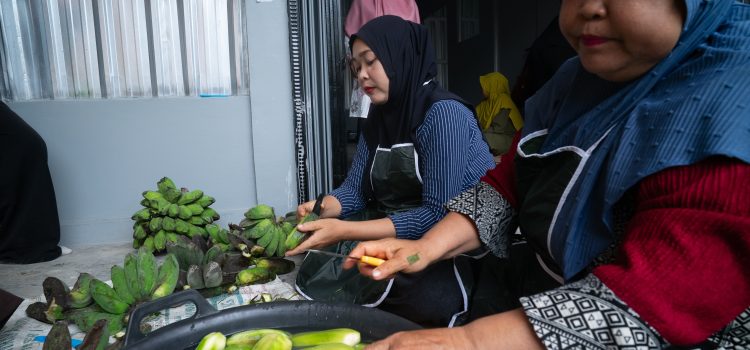
The process of making banana peel crackers in Matang Segarau continues to uphold traditional methods rooted in cooperation and communal values. The activity usually begins early in the morning, as women gather in a modest production house filled with the spirit of solidarity.
Bananas: A Leading Commodity of West Kalimantan
Bananas are one of West Kalimantan’s leading agricultural commodities. According to 2024 production data, the three districts with the highest banana yields are Mempawah, producing 66 million kilograms, followed by Bengkayang with 34.2 million kilograms, and Sambas in third place with 22 million kilograms. Together, these three districts contribute more than 80% of West Kalimantan’s total banana production, which reached 144.8 million kilograms that year.
Such vast potential also brings new challenges — particularly the significant increase in banana peel waste. Traditionally, banana peels are discarded as useless leftovers. Yet amid abundant harvests and growing environmental awareness, a new initiative has emerged, transforming how people perceive this agricultural waste.
A tangible example comes from Matang Segarau Village in Tekarang Subdistrict, Sambas Regency. Here, the women’s collective Serikat Perempuan Pantai Utara (Serumpun) pioneered the innovation of turning banana peels into banana peel crackers — a derivative product that is both economically valuable and environmentally friendly. This initiative represents a village-based circular economy, transforming agricultural waste into a source of income and women’s empowerment.
|
Kab/ Kota |
2019 | 2020 | 2021 | 2022 | 2023 |
2024 |
| Mempawah | 13,460,700 | 13,725,850 | 58,142,330 | 43,526,780 | 57,351,520 | 66,001,500 |
| Bengkayang | 1,780,000 | 7,228,100 | 58,100,200 | 46,612,200 | 50,018,500 | 34,249,600 |
| Sambas | 6,031,300 | 8,632,200 | 7,262,785 | 20,570,170 | 19,557,120 | 22,001,220 |
| Sanggau | 4,027,600 | 2,042,400 | 2,603,388 | 3,716,967 | 3,107,300 | 7,701,010 |
| Ketapang | 1,522,800 | 1,883,355 | 2,674,697 | 3,963,855 | 5,575,387 | 4,040,636 |
| Kubu Raya | 3,528,700 | 7,512,300 | 4,689,623 | 3,980,226 | 3,181,272 | 3,163,207 |
| Kota Singkawang | 8,984,700 | 5,512,10 | 1,473,700 | 5,479,800 | 3,937,400 | 2,870,100 |
| Kota Pontianak | 1,359,600 | 1,756,900 | 1,223,100 | 1,599,600 | 1,049,132 | 1,413,437 |
| Sintang | 3,523,800 | 2,144,900 | 2,838,400 | 2,129,560 | 1,624,280 | 1,181,630 |
| Landak | 425,500 | 370,700 | 226,708 | 141,700 | 128,400 | 834,300 |
| Kapuas Hulu | 1,258,920 | 8,652,800 | 705,620 | 1,289,452 | 1,156,040 | 624,156 |
| Melawi | 430,000 | 464,214 | 332,378 | 588,989 | 445,651 | 439,200 |
| Kayong Utara | 302,800 | 166,500 | 171,260 | 134,240 | 199,000 | 231,800 |
| Sekadau | 342,700 | 188,200 | 189,325 | 363,321 | 142,734 | 140,461 |
| Kalimantan Barat | 46,979,120 | 60,280,519 | 140,633,514 | 134,096,860 | 147,473,736 | 144,892,257 |
Source: BPS, 2025.
Traditional Methods That Bring Waste to Life
The process of making banana peel crackers in Matang Segarau continues to uphold traditional methods rooted in cooperation and communal values. The activity usually begins early in the morning, as women gather in a modest production house filled with the spirit of solidarity.
Freshly peeled banana skins are separated from their tough outer layer and soaked in salt water to reduce sap and bitterness. While some members oversee the soaking process, others prepare boiling water for the next step. The banana peels are boiled for 5–6 minutes until they darken in color and soften in texture. Once removed, they are air-cooled for about 10 minutes until naturally cooled.
The next stage involves preparing natural seasonings. From a stone mortar in the kitchen corner wafts the aroma of garlic, shallots, chili, coriander, and anchovies, all ground manually without a blender. This is a hallmark of the product: it contains no MSG, relying instead on the natural umami flavor from anchovies.
Once cooled, the banana peels are pounded until smooth to achieve a soft texture. This manual process is preferred, as it produces better consistency than a blender, which can be damaged by banana sap and often yields uneven results. The mashed banana peel is then mixed with tapioca flour and the prepared seasonings, kneaded by hand until it forms a smooth, elastic dough.
The dough is spread onto banana leaves softened over a fire to make them flexible and resistant to tearing. After flattening, the dough is steamed for 5–6 minutes until it turns translucent — a sign that it is fully cooked. The crackers are then sun-dried in two stages: first until semi-dry to make cutting easier, and then dried again until completely crisp under direct sunlight. The drying time depends on weather conditions, usually taking one to two days.
The final stage is frying. The dried crackers are fried in stable hot oil over medium heat to prevent burning. Once puffed and crispy, the crackers are cooled and packaged for sale.
All steps are carried out cooperatively: some women peel, some grind, others knead, dry, or package. This collective work reflects the spirit of kinship deeply rooted in Sambas culture, known locally through practices such as umme and belale’ — community-based mutual help. These local wisdom traditions embody the strength of women while giving rise to a new form of economic innovation grounded in environmental sustainability.
Today, what was once banana waste has become a local innovation supporting household economies, a testament to how creativity and collaboration can turn everyday byproducts into symbols of empowerment and resilience.
Authors: Ersa D. & Mohammad R., pegiat Gemawan
